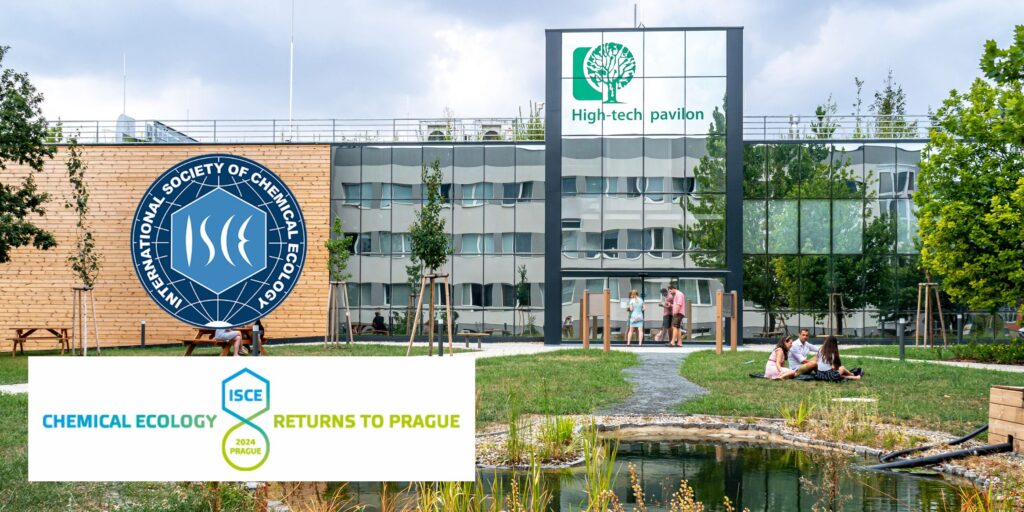13.7.2024 – Prague, Czech Republic
We are thrilled to announce that the RESDiNET team will be attending the 39th Annual Meeting of the International Society of Chemical Ecology (ISCE) in Prague, Czechia, from July 14-18, 2024. This prestigious conference, hosted at the Czech University of Life Sciences, marks the second time Prague has welcomed the ISCE, with the theme “Chemical Ecology Returns to Prague” paying tribute to its 1996 legacy.
Exploring the intersection of chemical ecology and remote sensing
Chemical ecology is vital for understanding the intricate interactions within ecosystems, particularly how organisms communicate and defend themselves through chemical signals. For the RESDiNET project, which focuses on the use of remote sensing methods and tools in forest disturbance ecology, this conference is an invaluable opportunity to integrate chemical ecology insights into our research.
By attending ISCE2024, we aim to deepen our understanding of how chemical signals can be detected and monitored using remote sensing technologies. This integration is crucial for tracking forest health, predicting disturbances, and managing threats like bark beetle infestations more effectively.
Special session highlight: Dr. Rastislav Jakuš
We are particularly excited about the special session sponsored by Synergy Semiochemicals Corp, where our project Coordinator, Dr. Rastislav Jakuš, will be presenting. Dr. Jakuš, Ph.D., DrSc., is a world-renowned expert in the chemical ecology of bark beetles and heads the Disturbance Ecology Team at the Institute of Forest Ecology, Slovak Academy of Sciences, Slovakia.
Presentation details:
- Date: Thursday, July 18, 2024
- Time: 12:30 – 12:45
- Location: High-Tech Pavilion, Room HT
- Title: “Spruce stands for protection against Ips typographus with anti-attractant blend of tree-based semiochemicals: experiments and conditions for practical applications.”
Dr. Jakuš will share his latest findings on using semiochemicals to protect spruce forests from Ips typographus. With over 35 years dedicated to this research, his insights will be invaluable for anyone interested in forest protection and pest management.
Additional session highlights
The session will also feature other notable speakers:
- Luca Deganutti & Massimo Faccoli (University of Padova, Italy) will present their research on push-and-pull applications against the European spruce bark beetle in the Eastern Italian Alps.
- Christian Donati & Veronica Gehza (Risolvo, Italy) will share results from their field experiments on the push-and-pull technique for protecting spruce trees over the past two years.
Why attend ISCE2024?
This conference offers a unique platform to explore a wide range of topics in chemical ecology through:
- 21 symposia: Covering diverse topics from microorganisms to humans.
- 50+ hours of talks: Including over 200 presentations on insect-plant interactions, molecular genetics, and more.
- 6 plenary lectures: Featuring world-renowned experts in chemical ecology.
- 2 poster sessions: Showcasing 88 posters with cutting-edge research and innovative ideas.
Special activities
Attendees can also enjoy various activities, including:
- Wednesday excursions: Explore Prague’s historical sites or visit the famous Pilsner Urquell brewery.
- Post-meeting field trip: Visit the National Park Bohemian Switzerland on July 19, 2024, to learn about the impact of bark beetles and recent forest fires.
- Farewell cocktail party: Enjoy a memorable evening at Lávka club near the Charles Bridge on July 18, 2024, starting at 20:00.
We are looking forward to connecting with fellow researchers and exploring new horizons in the world of chemical ecology and forest protection.
Stay updated on our latest activities by following us on our social media channels!
Instagram: www.instagram.com/resdinet
Facebook: www.facebook.com/resdinet
#ISCE2024 #ChemicalEcology #Prague #RESDiNRET #ForestProtection #RemoteSensing

